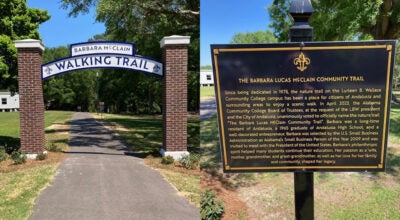Remember when: Historical Society celebrates 40 years
Published 10:35 pm Saturday, June 11, 2016
“There is a history in all men’s lives.” This is a Shakespeare quote from King Henry IV, Part II, that has been the motto of the Covington Historical Society since its founding in 1976. Mr. Joseph C. Wingard, the charter president, thoughtfully and carefully chose that line. Wingard, a retired teacher of English having taught for 39 years at the Andalusia High School, traveled to Great Britain three times and visited Shakespeare’s grave, birthplace in Stratford-upon-Avon, and the Globe Theatre.
 The society is celebrating its 40th anniversary in 2016 so the membership is determined to promote and publicize the history of Andalusia and Covington County to the fullest this banner year.
The society is celebrating its 40th anniversary in 2016 so the membership is determined to promote and publicize the history of Andalusia and Covington County to the fullest this banner year.
As many of you here in town have noticed, the Three Notch Museum has a brand new coat of exterior paint thanks to the recent work and donation of material from Sherwin-Williams along with the labor of a number of Andalusia and Opp painters including Steven Salter, Steve Young, Brian Carter, and Scott Baumgartner. Many thanks to contractor Robert Williams who suggested this benevolent project to the paint company. Much appreciation has been expressed to store manager, Shannon Bulger, to sales representative David Wilson, to Jerry Cross and the City of Andalusia who operated and furnished the lift, and to Linda Castleberry who supervised and participated in all the work.
The museum building is the converted and restored former Central of Georgia depot, the oldest wooden building in downtown Andalusia (Circa 1900). It is located in the heart or center of town only a stone’s throw from where the 40 survey lines converge. The property is listed on the National Register of Historic Places. Housed in this structure is a treasure of artifacts relating to this community’s history. Items have been donated over the past 30 years, one by one, thanks to citizens who have deemed it fitting to contribute what might be sentimental to their family or their business but what they feel is more important to be shared especially with school children and younger generations to honor what has gone on before so that the story of their gift and how it relates to our history might not be lost. Let me take you on a brief walk through the museum.
Indian relics including arrowheads, tools, and weapons are on display. There is a need for these to be labeled properly by an expert. Some sand dollars that were spotted in a shallow sand dollar river bed just a little south of the Brooklyn Bridge were donated by a fisherman who told this writer about his find. This goes along with the white beach sand containing mica, sparkly particles which came from a certain water well being drilled off Antioch Road in the late 1970’s by the Andalusia Industrial Development Board. The geologist on site during the drilling stated that at one time the Hudson Bay extended down from Canada all the way to the Gulf of Mexico, and today we can only surmise that this area was under water at some period of time in history many, many years ago. As one real estate agent exclaimed, “Oh, my, we could be selling beachfront property!” By the way, the “beach” sand was found 960 feet down and was drilled with a 12-inch drill bit. The late Andy Floyd donated the bottle of this beach sand at the time the water tank was being installed for the construction of Amoco Fabrics now known as Shaw Industries.
Many visitors have viewed the wealth of panoramic photos in the Alatex collection. That story of the textile industry was a part of some 70 years of Andalusia history (1920’s – 1990’s).
The impact this company made on this town and the communities of the other branch factories can still be felt.
The Flood of 1929 photos (E. L. More collection) portraying the extensive and irreparable damage incurred of River Falls and the Horse Shoe Lumber Company are of interest to many who follow the development of the Gantt and Point A dams which brought permanent electric power to South Alabama and surrounding areas.
Can you imagine the difficulty it was to local residents for the electrical power in town to be shut down around ten o’clock at night only to be powered on around five thirty in the mornings?
A nocturnal candlelit home was not ideal! That is when electricity was generated in downtown in the vicinity of what is now the Power Plant Marketplace, the manufacturing district. The cross ties that were manufactured from the availability of pines in the forests of Covington County made it possible for the train line to be extended from Searight into downtown Andalusia at the turn of the 20th century. One can only envision the excitement of the first trains steaming into town beginning in 1899. Old timers remember seafood from New Orleans being shipped in and loads of mules arriving and being unloaded and driven around from the depot circling the square and then secured at the O’Neal Mule Barn on O’Neal Court. That short street was once shown on some old maps as North Three Notch Street.
Small town Andalusia has produced through the years some outstanding young people. One of these boys who grew up on Rankin Street and graduated from AHS (Class of 1939) was Charles Brooks who became a newspaper editorial cartoonist for The Birmingham News for some 38 years. Brooks drew with pen point many pictures, some political in nature, some satirical having to do with the news of the day, but his most famous was the one he created when Walt Disney passed away.
In 1966 hearing the news at the newspaper office in the early afternoon, Brooks went to a drug store and bought some comic books with pictures of Disney’s characters. His deadline for submission was eight o’clock that evening.
By that time, he had drawn a collage including Mickey Mouse, Donald Duck, Goofy, Pluto, Snow White, Cinderella, Porky Pig, Elmer Fudd, the Seven Dwarfs, and numerous others standing around the grave of Walt Disney with big tears in their eyes. That emotional cartoon was wired to major newspapers around the country where it appeared nationwide touching the hearts of many. The Disney family heard about it, and they made a special request of Brooks asking if he would send them the original which he did. It was placed in the Disney headquarters at Disneyland in California. That was a significant event in the career of the late Charles Brooks, Andalusia native, who sketched his way through public school right here in Andy. That is the example of only one success story of one such former Andalusian, hometown artist with small town roots. Much of his works are on display at the Three Notch Museum.
This story serves as an encouragement to young people to let them know that even though they are from a small town, whatever they dream to do can come true as it did for Charles Brooks.
Don’t miss looking over the William “Chick” Earle Little League sports memorabilia; the Southern Craftsman Victorian reproduction furniture that was at one time manufactured in Andalusia with some pieces making their way to Hollywood movie sets for use in the “technicolor” cowboy movies and to homes all over America; an icebox (refrigerator) that once awaited the weekly visit from the Consumers Ice and Cold Storage ice man; the pioneer farming implements that plowed, planted, and harvested their way through this county’s history; the bottle collection from Chero-Cola, It-Cola, RC Cola, and Coca Cola Andalusia history; the aged quilts and needlework items that show the handiwork of the talented and patient home seamstresses; a genuine Purple Heart award of an Opp soldier, Lenton Mack; vintage chairs and spittoon from the old courthouse; a doctor’s bag and log books from the Red Level Dr. James Edward Terry medical practice when getting paid by turnips, chicken eggs, butter, syrup, and firewood was common place; the Speller Moates radio collection which brought families news, sports, entertainment, live music from Radio City Music Hall in NYC before tv became king; a Circa 1890’s church pump organ (Richard Kearley family donation) used typically in community churches around the county; a wooden casket box which shipped a deceased soldier back by train from a WWII battlefield (Benny Barrow donation); a working model train exhibit (Mark Gibson family donation) that children are enthralled by; an authentic and probably the original Magnolia Cemetery iron archway entrance resembling a scene in a John Wayne cowboy movie that was found in a downtown building and donated by John Tisdale; the antique glass cabinet from the old Thagard-Mallette Drug Store on Pear Street that now displays gift shop items including the “Andalusia” book written by Dr. Bill Hansford in collaboration with Linda Brogden Palmer and the “Historic Coloring Book” reprinted recently and made possible by the CCB Community Bank.
The interiors of the Clark family log cabin, the H.B. Little country store, and the River Falls post office remind visitors of days gone by in an era of mule and wagons, overalls and sun bonnets, corn cob mops and snuff cans, grandfather clocks and traveling trunks, checker boards and 19th century McGuffey Readers, peppermint sticks and flour sacks.
The dream of a local history museum housed in the former Central of Georgia depot was made possible in the mid 1980’s by Alabama Electric now Power South. The Covington Historical Society and the many hundreds who have contributed to and toured this facility have not forgotten their generosity. The Altrusa Club at the suggestion and benevolence of the late Lela Mae Holmes who donated their club house, the Sunshine House, to the society added a large source of revenue to the CHS as did the E. L. More and Livingfield More family of Horse Shoe Lumber Company fame. Additionally, the City of Andalusia partners with the society to assist with the operating expenses of this facility. The city’s civic clubs have remembered the museum project faithfully. Memorial and honorarium contributions are always welcome.
The donation of artifacts is still ongoing as museum treasures surface in attics, basements, garages, and estate sales.
For Andalusia to have a museum to serve not only as an educational source but also as a tourist attraction helps us one and all to step back in time from a proud past toward a promising future. This enables us to enjoy the stories of the past and to understand where we have been so we can appreciate the present. Check out the Facebook page and the website, www.3nmsm.com. Do make plans to visit Three Notch Museum this summer and REMEMBER WHEN.





